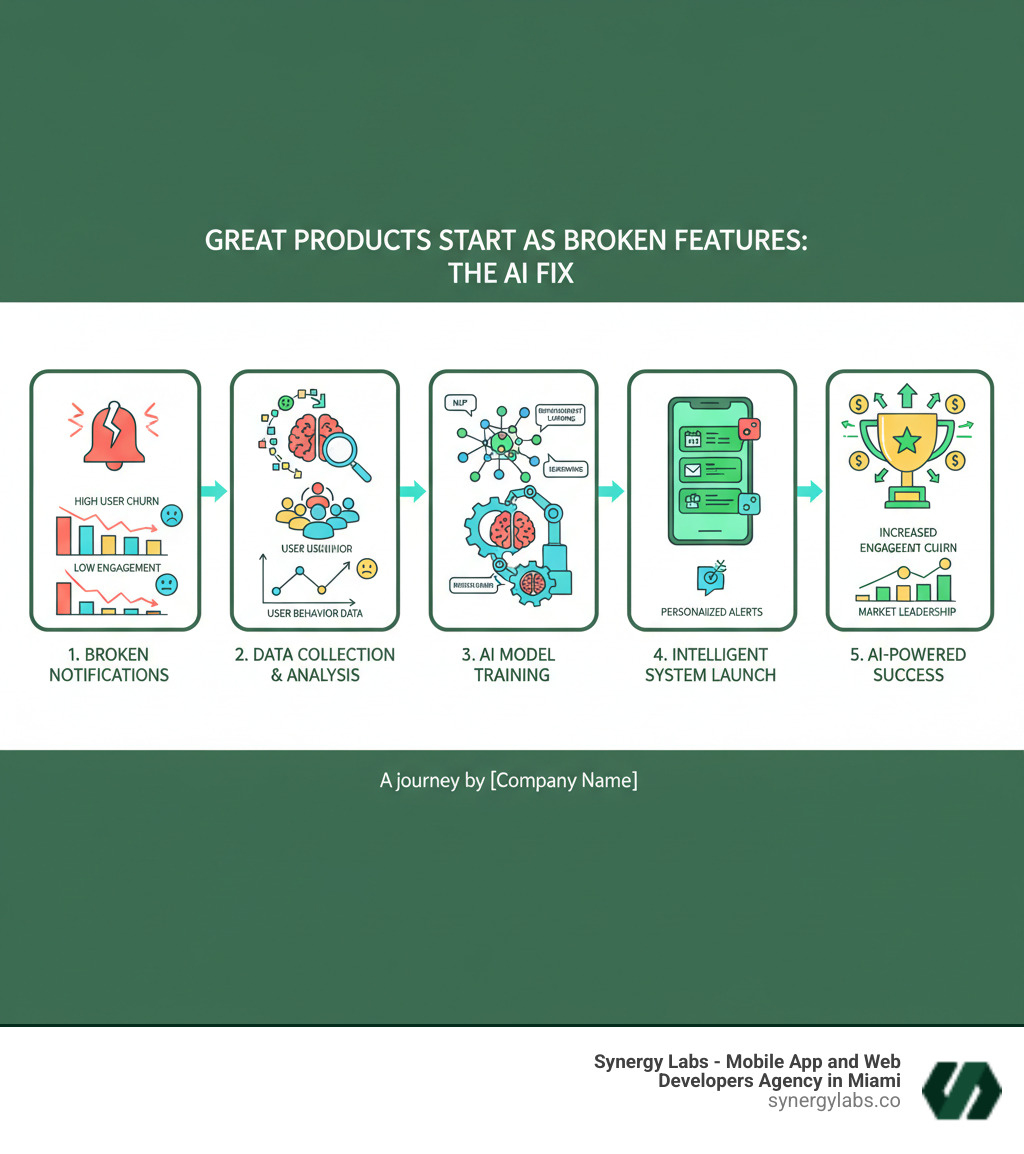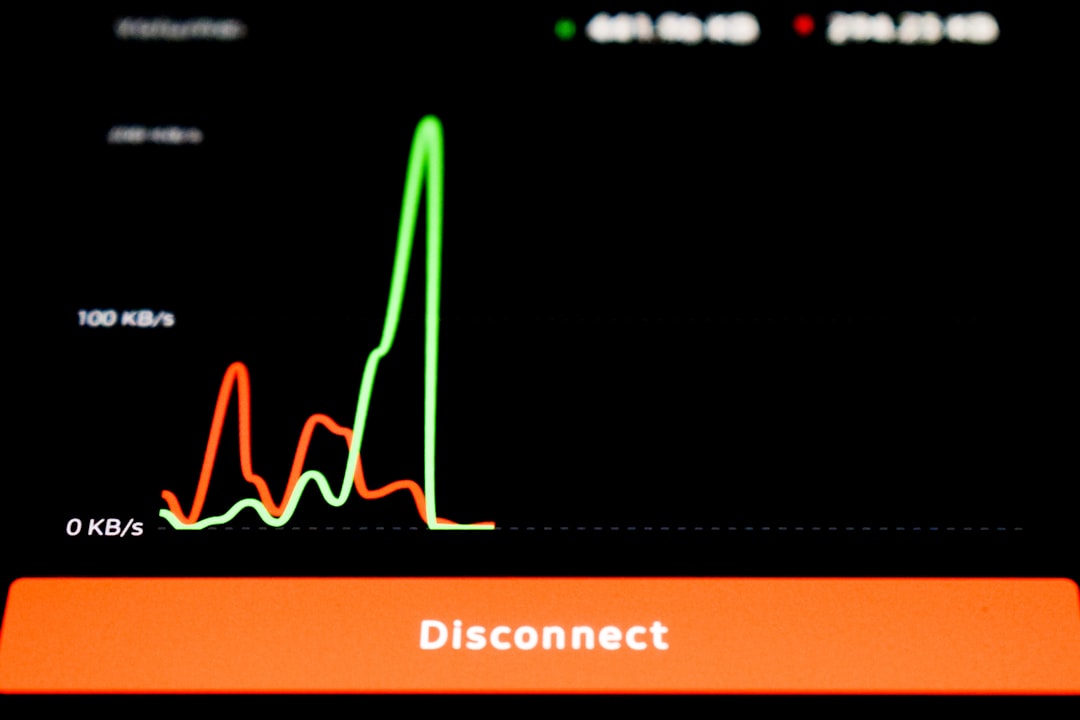الشراكة مع وكالة من أفضل الوكالات
حدد موعدًاللاجتماع عبر النموذج هنا و
سنقوم بتوصيلك مباشرةً بمدير المنتجات لدينا - دون مشاركة مندوبي المبيعات.
هل تفضل التحدث الآن؟
اتصل بنا على + 1 (645) 444 - 1069
"A lesson most founders learn the hard way. The pressure to launch a flawless product is immense, but reality is often messy."

Great Products Start as Broken Features: The AI Fix Behind WisprFlow's Success is a lesson most founders learn the hard way. The pressure to launch a flawless product is immense, but reality is often messy. Many successful products evolved from features that initially failed.
Quick Answer: WisprFlow's Path from Broken to Breakthrough
Most founders chase perfection at launch, but history shows a different path. Many iconic products we use today started with significant flaws, lacking features we now consider essential.
WisprFlow followed this pattern. Its original notification system was so broken it created more chaos than it solved, bombarding users with irrelevant alerts. Support tickets flooded in and churn rates climbed.
Instead of scrapping it, the team asked a better question: What if the system could learn from user behavior?
That single question led them to AI and a breakthrough success. The broken feature wasn't a failure; it was a goldmine of behavioral data. Every dismissed notification and frustrated click told a story, revealing patterns in the chaos. Those patterns became the foundation for an AI that could predict what users actually wanted.
This is the story of how WisprFlow turned its biggest flaw into its strongest competitive advantage. At Synergy Labs, we've helped many startups turn similar challenges into AI-powered wins, proving that the right AI strategy can transform a problem into a breakthrough.

Imagine your phone constantly buzzing with a cacophony of digital noise. This was the "broken feature" WisprFlow inadvertently created. Their product, aiming to keep users informed, instead became a source of immense frustration. The challenge wasn't a lack of notifications, but an overwhelming, untargeted flood of them.
WisprFlow's vision was to deliver timely, relevant information. However, their notification system missed the mark. It operated on simple, rule-based logic: if X happens, send Y notification. This approach failed to account for individual preferences or context, resulting in a system that treated all users equally and led to an onslaught of irrelevant messages.
Users quickly grew weary of notifications about things they didn't care about, at inconvenient times. This led to notification overload, where the signal was lost in the noise. The feature, intended to be helpful, became a nuisance that detracted from the user experience.
While specific figures are proprietary, the symptoms they experienced are common indicators of a broken feature:
This data showed the notification feature was a liability, actively driving users away. It was a classic example of a well-intentioned feature that was fundamentally broken in its implementation.
Most companies facing this level of user frustration would either scrap the feature or patch it with more complex rules. WisprFlow's team considered both options while staring at dashboards filled with red metrics.
Then, someone asked a different question: "What if the system could learn from user behavior?"
That single question changed everything. It reframed the problem entirely. The team realized they'd been trying to create perfect rules when they needed a system that could adapt to each user. This shift from reactive to predictive thinking was the breakthrough. Instead of asking, "How do we stop annoying users?" they asked, "How can we understand what each user wants to see?" One question leads to more rules; the other leads to AI.
The "what if" moment that defines Great Products Start as Broken Features: The AI Fix Behind WisprFlow's Success is about perspective. It's recognizing that even frustrated user behavior is valuable data. At Synergy Labs, our AI strategy services help teams identify when a problem is an opportunity in disguise, guiding them to ask better questions about user needs.
The counterintuitive truth is that WisprFlow's broken notification system was a gift because of its flaws.
They had accumulated months of data: users dismissing notifications, patterns of which alerts were opened, and which types caused users to disable the system entirely. Every frustrated tap was a data point.
This was a rich dataset that a perfectly functioning system might have hidden. The unfiltered user behavior was raw and honest. When a system is truly broken, users tell you exactly how they feel through their actions. That clarity became invaluable.
For learning models, this diverse, emotionally-charged data is gold. Machine learning thrives on variety and extremes, learning from both successes and spectacular failures. WisprFlow's chaotic early days provided both.
Most importantly, the flaw became their unique advantage. While competitors built systems on assumptions, WisprFlow's AI was built on hard evidence of what users rejected and accepted. The chaos contained patterns, the frustration contained truth, and that truth became the foundation for something remarkable.
With a mountain of user data and a clear vision, the WisprFlow team began rebuilding their notification system from the ground up. They aimed to create a finely tuned assistant that understood user needs. The journey was iterative, but it proved that Great Products Start as Broken Features: The AI Fix Behind WisprFlow's Success is a practical roadmap.

To predict what users wanted, WisprFlow assembled a powerful AI tech stack.
These technologies worked together, creating a system far more powerful than the sum of its parts.
The path to success was marked by four critical milestones.
WisprFlow's success demonstrates a strategy accessible to any company willing to innovate, a trend reflected in the broader industry pivot to AI. At Synergy Labs, we guide startups through similar AI changes, combining technical expertise with a deep understanding of user behavior to turn broken features into breakthroughs.
The change of WisprFlow's notification system embodies a key truth: Great Products Start as Broken Features: The AI Fix Behind WisprFlow's Success is a roadmap for innovation. By embracing the chaos and applying intelligent AI, WisprFlow didn't just patch a problem; they created a product users genuinely loved.
What set WisprFlow apart was how they fixed their problem. While competitors tweaked rules, WisprFlow took a different path. Traditional systems are rigid, following preset rules. WisprFlow's AI-powered approach transcended these rule-based systems by understanding context.
For example, the AI learned that a message from a boss on a Monday morning deserves immediate attention, while a promotional offer at 2 AM can wait. This contextual intelligence made all the difference. The adaptive technology, powered by reinforcement learning, evolved continuously with every user interaction. The system didn't just adapt to individuals; it learned from millions of collective interactions, becoming smarter daily.
Perhaps the most compelling aspect was the zero-configuration setup. WisprFlow eliminated the need for users to fiddle with complex settings. The system figured out what users wanted on its own. This "it just works" factor resonated with users tired of being their own tech support, aligning with the demand for user-friendly AI tools. The result was true personalization, making the app feel like it truly understood its users.
The numbers told an undeniable story. The AI-powered change revolutionized WisprFlow's business trajectory.

All of this translated into substantial revenue growth and established the company as a market leader. They proved that even a feature so broken it drives users away can become the foundation for something exceptional by solving a real problem in a neat way.
At Synergy Labs, we've seen similar changes with many other apps. The pattern is consistent: identify the problem, collect data, apply intelligent solutions, and iterate. Great Products Start as Broken Features: The AI Fix Behind WisprFlow's Success isn't just one company's story—it's a blueprint that works.
The best candidates are features with high user interaction but low satisfaction. If users need a feature but are frustrated by the experience, that's your opportunity. Problems that involve personalization, prediction, or operating at a large scale are also prime candidates for an AI solution. The key question isn't "Is this broken?" but "Could this learn to be better?" Look for patterns in your data, like users constantly changing settings or disabling features, as these are signals of a learning opportunity.
Before touching any algorithms, start with your data. The first step isn't coding; it's listening to what your data is already telling you. Define the problem with specifics (e.g., "80% of notifications are dismissed in under 2 seconds"). Then, inventory your existing data—usage logs, click patterns, user feedback—and assess its quality. Clean, well-structured data is crucial. Finally, analyze the data to find patterns that differentiate successful interactions from frustrating ones. This groundwork is essential; even the best AI model can't learn from data you don't understand.
There's no magic number; it depends on the complexity of your problem. However, quality beats quantity every time. A smaller, highly relevant, and accurate dataset will outperform a massive, noisy one. For example, a simple recommendation engine might only need a few thousand interactions, while a complex language model could require millions. You can also use transfer learning, fine-tuning pre-trained models with your specific data, which dramatically reduces the amount you need to get started. Our advice at Synergy Labs is to start small with high-quality data, build a minimal viable model, and iterate as you learn. The goal is to gather the right information to solve your problem.
Most founders believe they need a flawless product at launch, but as WisprFlow's story shows, that's a myth. Their original notification system created chaos, but instead of scrapping it, they asked a better question: What if the system could learn? That question led them to AI and, ultimately, to market leadership.
The narrative of WisprFlow is a powerful testament to the idea that Great Products Start as Broken Features: The AI Fix Behind WisprFlow's Success. It's a story not about avoiding failure, but about embracing it as fuel for innovation. Their journey shows that our biggest problems often hide our most significant breakthroughs.
This mindset changes everything. When you view flaws as opportunities and user behavior as data, you open doors to innovation. WisprFlow's chaotic feature wasn't a problem; it was a goldmine of behavioral data. They just needed the right technology to open up its insights. This is the power of building systems that learn, adapt, and genuinely serve users.
If you're ready to transform a challenging feature into a competitive advantage, the expert developers at Synergy Labs are here to guide you. We specialize in crafting high-quality, scalable apps and integrating cutting-edge AI solutions that turn problems into products people love. We've walked this path with many companies, and we understand the road from broken to breakthrough.
Your breakthrough product might be closer than you think. That feature keeping you up at night could be your biggest opportunity.
Let's build your breakthrough product together. Contact us today to start your AI journey.

البدء سهل! ما عليك سوى التواصل معنا من خلال مشاركة فكرتك من خلال نموذج الاتصال الخاص بنا. سيرد أحد أعضاء فريقنا في غضون يوم عمل واحد عبر البريد الإلكتروني أو الهاتف لمناقشة مشروعك بالتفصيل. نحن متحمسون لمساعدتك في تحويل رؤيتك إلى حقيقة!
إن اختيار SynergyLabs يعني الشراكة مع وكالة تطوير تطبيقات جوال من الدرجة الأولى تعطي الأولوية لاحتياجاتك. إن فريقنا الذي يتخذ من الولايات المتحدة مقراً له بالكامل مكرس لتقديم تطبيقات عالية الجودة وقابلة للتطوير ومتعددة المنصات بسرعة وبتكلفة معقولة. نحن نركز على الخدمة الشخصية، مما يضمن لك العمل مباشرةً مع كبار المواهب في جميع مراحل مشروعك. إن التزامنا بالابتكار ورضا العملاء والتواصل الشفاف يميزنا عن الوكالات الأخرى. مع SynergyLabs، يمكنك أن تثق في أن رؤيتك ستُنفذ بخبرة وعناية.
عادةً ما نطلق التطبيقات في غضون 6 إلى 8 أسابيع، اعتماداً على مدى تعقيد مشروعك وميزاته. تضمن لك عملية التطوير المبسّطة التي نتبعها طرح تطبيقك في السوق بسرعة مع الاستمرار في الحصول على منتج عالي الجودة.
تتيح لنا طريقتنا في التطوير عبر المنصات المتعددة إنشاء تطبيقات الويب والهاتف المحمول في نفس الوقت. وهذا يعني أن تطبيقك على الهاتف المحمول سيكون متاحاً على كل من نظامي iOS وAndroid، مما يضمن لك انتشاراً واسعاً وتجربة مستخدم سلسة على جميع الأجهزة. يساعدك نهجنا على توفير الوقت والموارد مع زيادة إمكانات تطبيقك إلى أقصى حد.
في SynergyLabs، نستخدم مجموعة متنوعة من لغات البرمجة وأطر العمل لتناسب احتياجات مشروعك على أفضل وجه. بالنسبة للتطوير عبر المنصات، نستخدم لغة Flutter أو Flutterflow، والتي تتيح لنا دعم الويب وأندرويد وiOS بكفاءة من خلال قاعدة برمجة واحدة - وهي مثالية للمشاريع ذات الميزانيات المحدودة. بالنسبة للتطبيقات المحلية، نستخدم سويفت لتطبيقات iOS وكوتلين لتطبيقات أندرويد.




بالنسبة لتطبيقات الويب، نجمع بين أطر تخطيط الواجهة الأمامية مثل Ant Design أو Material Design مع React. على الواجهة الخلفية، نستخدم عادةً Laravel أو Yii2 للمشاريع المتجانسة، و Node.js للبنى بدون خادم.






بالإضافة إلى ذلك، يمكننا دعم العديد من التقنيات، بما في ذلك Microsoft Azure وGoogle Cloud وFirebase وAmazon Web Services (AWS) وReact Native وDocker وNGINX وApache وغيرها. تُمكِّننا مجموعة المهارات المتنوعة هذه من تقديم حلول قوية وقابلة للتطوير مصممة خصيصاً لتلبية متطلباتك الخاصة.








الأمن أولوية قصوى بالنسبة لنا. نحن ننفذ تدابير أمنية متوافقة مع معايير الصناعة، بما في ذلك تشفير البيانات، وممارسات الترميز الآمنة، وعمليات التدقيق الأمني المنتظمة، لحماية تطبيقك وبيانات المستخدم.
نعم، نحن نقدم الدعم والصيانة والتحديثات المستمرة لتطبيقك. بعد الانتهاء من مشروعك، ستتلقى ما يصل إلى 4 أسابيع من الصيانة المجانية لضمان سير كل شيء بسلاسة. بعد هذه الفترة، نوفر خيارات دعم مستمرة مرنة مصممة خصيصاً لتلبية احتياجاتك، حتى تتمكن من التركيز على تنمية أعمالك بينما نتولى نحن صيانة تطبيقك وتحديثاته.